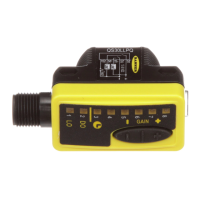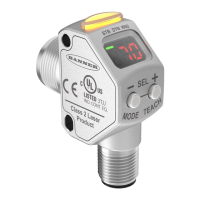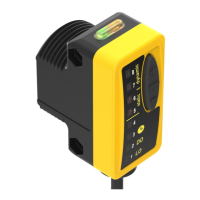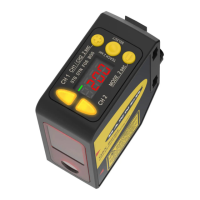17 © Banner Engineering Corp. www.bannerengineering.com
SENSOR PROGRAMMING
3.2.3. Loss of Signal (LOS)
Use this menu to select the Analog Output value used by the sensor during a loss of signal. When a signal is restored, measurement resumes.
The default is 0 V (4 mA).
The Range advanced measurement behavior is affected by the Loss of Signal option. For additional information on advanced measurements,
see Trigger (trG) on page 17. The Range advanced measurement tracks a maximum and a minimum during the measurement period, and calcu-
lates the range as follows:
Range = maximum distance – minimum distance
If the maximum and/or minimum measurements are outside of the taught range values, the Loss of Signal option determines how the range is
calculated.
3.2.4. Input Wire Function (inPt)
Use this menu to select the input wire function. The default is off, ignore all remote input pulses.
• oFF—Ignore all remote input pulses
• SEt—Remote TEACH input
• LoFF—Laser off when pulled low
• Lon—Laser on when pulled low
• nASt—Master sync line output for two-sensor cross-talk avoidance
• SLUE—Slave sync line input for two-sensor cross-talk avoidance
• trG—Trigger mode for advanced measurements (see Trigger (trG) on page 17)
To configure sensors for master-slave operation, see Sync Master/Slave on page 28.
3.2.5. Trigger (trG)
The Trigger option sets the advanced measurement that is calculated when a trigger event is detected on the remote input.
The analog output updates with the new advanced measurement on each trigger event. To use these Trigger options, the sensor Input Type
option must be set to trG.
One reference surface is taught outside the
sensing range
Sets a dual (intensity + distance) window
centered around the taught reference surface
that is outside the sensing range. The sensing
conditions may not be as reliable.
out flashes on the display.
One invalid TEACH Point No reference surface is taught, the output will
change when any object is detected.
FuLL flashes on the display.
Table 6:Analog output value during a loss of signal
Option Description
0 V (4 mA)—default
The Analog Output switches to this value 2 seconds after a loss of signal. When advanced measurements are
enabled, the Analog Output is updated to this value immediately upon the release of the trigger input.
10.5 V (20.5 mA)
The Analog Output switches to this value 2 seconds after a loss of signal. When advanced measurements are
enabled, the Analog Output is updated to this value immediately upon the release of the trigger input.
Hold
The Analog Output holds the last value indefinitely during a loss of signal. When advanced measurements are
enabled, the last value is held across the triggered measurement periods.
Table 7:Sensor behavior in range mode
Option Description
0 V (4 mA)
If the maximum or minimum measurement is outside of the taught range values, the sensor outputs 0 V (4 mA) to
indicate an out-of-range measurement.
10.5 V (20.5 mA)
If the maximum or minimum measurement is outside of the taught range values, the sensor outputs 10.5 V (20.5
mA) to indicate an out-of-range measurement.
Hold
The sensor limits the maximum and minimum measurements so that they cannot exceed the taught range
values.
Table 5:Expected TEACH Behavior for Dual (Intensity + Distance) Mode (Continued) (Sheet 2 of 2)
Condition TEACH Result Display
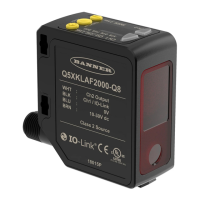
